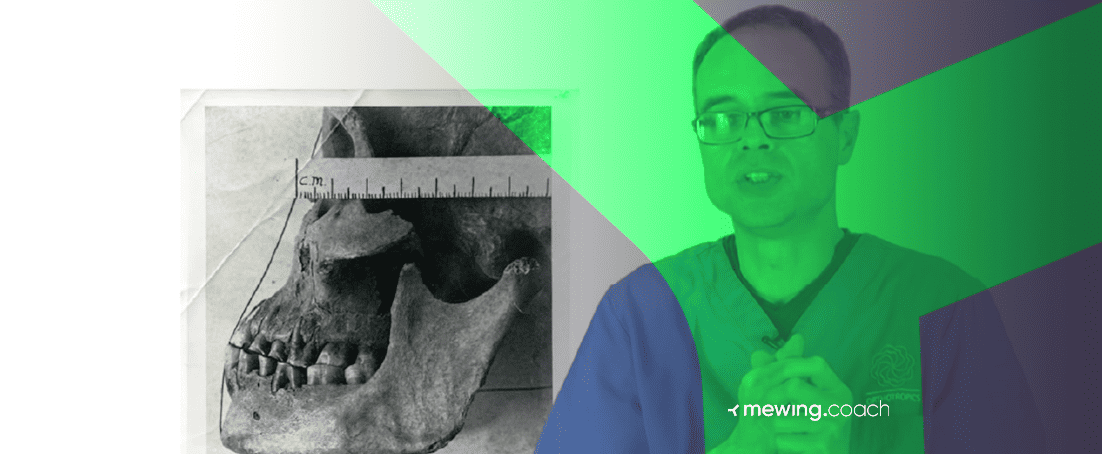Do you clench your teeth subconsciously? Do you grind them in your sleep without knowing? This condition has a name – bruxism.
But is there a way to fix this issue using myofunctional therapy? Well, there is one way – through mewing.
Thus, in this article, we’ll tell you:
- ❓ What is bruxism?
- ❓ What causes bruxism?
- ❓ How to get rid of bruxism while mewing?
- ❗ Mewing results, before and after
- ❓ How long does it take to get rid of bruxism while mewing?
- 😬 How to prevent bruxism?
So, how are your teeth supposed to sit to prevent bruxism? Keep reading to find out.

What Is Bruxism?
Bruxism (or teeth grinding) is a recurring movement of the jaw or jaw muscles, which results in grinding or clenching of the teeth.
While it may seem like an annoyance, bruxism can seriously damage your teeth and gums. Some forms of bruxism are linked to sleep apnea or periodontal disease – conditions that can cause tooth decay or gum disease if left untreated. This abnormal behavior can cause damage to the jawbone and lead to pain, headaches, jaw pain, and other symptoms.
In severe cases, bruxism can lead to tooth fractures and jaw dislocation. Adopting a correct mewing technique can prevent this in the long run.
Causes of Bruxism
While there’s no single cause for bruxism, there are some common risk factors that may help explain why you experience mewing bruxism. These include:
- Stress. Stress can lead to increased levels of cortisol in your system, a hormone that can increase jaw clenching and grinding.
- Tumor growth. Increased tumor growth in the head and neck region is another possible reason for bruxism.
- Poor sleep habits. A lack of good quality sleep time can lead to bruxism as well.
- Family members who suffer from bruxism. Bruxism during sleep is often hereditary. If you grind your teeth, other family members could be doing the same or have a history of doing so.
- Other disorders. Some physical and mental health conditions, including Parkinson’s disease, dementia, gastroesophageal reflux disease (GERD), epilepsy, night terrors, and sleep-related conditions, including sleep apnea, can all lead to bruxism.
How to Get Rid of Bruxism With Mewing
So, what does mewing do?
The process of mewing is named after British orthodontist Dr. Michael Mew and his son Dr. John Mew. Mewing involves training your tongue to press firmly on the roof of your mouth.
It will take some time to get used to it because most individuals tend to rest their tongues away from the roof of the mouth.
Some people think that performing it regularly for years can:
- Define the jaw
- Help you breathe properly
- Aid in tongue realignment
- Relieve jaw discomfort
- Reduce snoring.
But does mewing straighten teeth? In some cases, it does – especially in children, whose teeth are still developing and actively changing.
How Mewing.coach Can Help
If you don’t know how to mew – the app Mewing.coach can help. Our app offers the option for a personalized mewing plan and will create it once you complete a quiz describing your mewing objectives (in this case, bruxism).
You can get it via the App or Play Store, and once you set it up and complete the quiz, you’ll be able to access endless info on mewing and even watch some video tutorials.
Mewing Results: Before and After Bruxism
You can see in these mewing progress pictures that the mouth is much more relaxed. Learning good tongue posture entails learning how to relax your jaw and where to put your teeth, which eliminates bruxism.
The results will be noticeable in your posture, nose, and lips, boosting your oral health and eliminating mouth breathing and jaw tension. Teeth grinding can be serious for your oral health, and although Dr. Mike Mew guarantees results, you will have to reduce your stress level, improve your diet, and sleep at least 8 hours at night.
How Long Does It Take to Get Rid of Bruxism While Mewing
You won’t see effects right away from mewing. For instance, it may take 3 to 6 months or even up to 2 years for some people to detect changes in their faces. This mewing proof might help you understand this better.
Due to their developing body and the benefit of quicker outcomes due to their young age, children may have an easier time seeing results. Adults have a physique that is already used to certain behaviors. For instance, basic jawline and health improvements may become apparent in 1 to 3 months, but very significant, aesthetically pleasing changes may take longer.
For results to be guaranteed, you must try not to make mewing mistakes.
How to Prevent Bruxism Recurrence
People clench their teeth for several reasons, but you can do a few things to prevent it. While these techniques could be useful, each person responds differently to a treatment.
It is very useful to see your dentist before making any changes to your routine and take any advice they may provide on how to stop teeth clenching. Check out our article on mewing with braces if you wear any type of retainers.
Other Bruxism Treatments
Besides mewing, you can aid bruxism in several ways:
Dentist Treatments
A mouth guard, bite splint, or dental splint may be recommended by your dentist. These are worn at night to keep your teeth safe from injury. A dentist may craft them to fit perfectly over your upper or lower teeth.
When tooth wear has caused extreme discomfort or an inability to chew correctly, your dentist may need to restructure the chewing surfaces of your teeth or place crowns to heal the damage.
Medical treatment from a GP
The following are some examples of drugs that can be used to treat bruxism:
- Muscle relaxants. In some circumstances, your doctor could advise using a muscle relaxant just before bed for a brief amount of time.
- Botox injections. Some persons with severe bruxism who don’t react to conventional therapies may benefit from botox injections.
- Anxiety or stress medication. Your doctor can advise using antidepressants or anti-anxiety drugs for a brief period to help you cope with stress or other emotional problems that could be the root of your bruxism.
Mewing and Malocclusions
We know that mewing helps with bruxism, but what about malocclusions? So, can mewing fix overbite? In most cases, it can improve it and make it more subtle.
Mewing with underbite is also recommended, and so is crossbite treatment with mewing.
Conclusion
Teeth grinding can be resolved with mewing. Just download the app Mewing.coach – it will become your favorite workout program! Answer a quick quiz to receive your workout program for your jaw and facial muscles.
Improve your facial aesthetics and health with the world-renowned mewing technique. Be patient and you will prevent teeth grinding soon enough!





